Sustainable Conservation Tillage Technique for Improving Soil Health by Enhancing Soil Physicochemical Quality Indicators under Wheat Mono-Cropping System Conditions
Abstract
1. Introduction
2. Materials and Methods
2.1. Research Site Description
2.2. Experimental Design and Setup
2.3. Soil Sampling Collection and Analysis
2.3.1. Soil Physical Properties
2.3.2. Soil Chemical Properties
2.3.3. Agronomic Traits
2.4. Determination of Soil Health
2.5. Statistical Analysis
3. Results
3.1. Soil Physicochemical Quality Indicators
3.2. Rainfall and Air Temperature
3.3. Effect of Treatments on Bulk Density in the Different Layer
3.4. Effects on Soil Porosity in the Different Layer
3.5. Effect of Treatments on Soil Hydraulic Conductivity in the Different Layer
3.6. Effects of Treatments on Soil Gravimetric Water Content and Soil Water Storage in Early and Late Crop Growth Stages
3.7. Effects of Treatments on Soil Temperature in the Different Soil Layers
3.8. Influence of Treatments on Soil Chemical Indicators in the Different Soil Layers
3.9. Effects on Crop Agronomic Traits
4. Discussion
4.1. Tillage Effects on Soil Bulk Density
4.2. Tillage Impacts on Soil Pore Space
4.3. Influences of Conservation Tillage System on Hydraulic Conductivity
4.4. Tillage Effects on Soil Water Content and Storage
4.5. Influences of Tillage System on Soil Temperature
4.6. Effect of Tillage Systems on Soil TN, AP, TK, C/N Ratio, pH and The Corresponding Z Score
4.7. Influence of Conservation Tillage System on Crop Agronomic Traits
4.8. Soil Health
5. Conclusions
Supplementary Materials
Author Contributions
Funding
Institutional Review Board Statement
Informed Consent Statement
Data Availability Statement
Acknowledgments
Conflicts of Interest
References
- Sadiq, M.; Li, G.; Rahim, N.; Tahir, M.M. Effect of conservation tillage on yield of spring wheat (Triticum aestivum L.) and soil mineral nitrogen and carbon content. Int. Agrophys. 2021, 35, 83–95. [Google Scholar] [CrossRef]
- Wulanningtyas, H.S.; Yingting, G.; Peiran, L.; Nobuo, S.; Junko, N.; Masakazu, K. A cover crop and no-tillage system for enhancing soil health by increasing soil organic matter in soybean cultivation. Soil Tillage Res. 2021, 205, 104749. [Google Scholar] [CrossRef]
- de Carcer, P.S.; Sokrat, S.; Ma, S.; Dario, F.; Bernard, J. Long-term effects of crop succession, soil tillage and climate on wheat yield and soil properties. Soil Tillage Res. 2019, 190, 209–219. [Google Scholar] [CrossRef]
- Xie, J.; Chen, J.; Sun, G.; Zha, T.; Yang, B.; Chu, H.; Liu, J.; Wan, S.; Zhou, C.; Ma, H.; et al. Ten year variability in ecosystem water use efficiency in an oak-dominated temperate forest under a warming climate. Agric. For. Meteorol. 2016, 218–219, 209–217. [Google Scholar] [CrossRef]
- Blanco-Canqui, H.; Ruis, S.J. No-tillage and soil physical environment. Geoderma 2018, 326, 164–200. [Google Scholar] [CrossRef]
- Jabro, J.D.; Stevens, W.B.; Iversen, W.M.; Evans, R.G. Bulk density, water content, and hydraulic properties of a sandy loam soil following conventional or strip tillage. Appl. Eng. Agric. 2011, 27, 765–768. [Google Scholar] [CrossRef]
- Castellanos-Navarrete, A.; Rodriguez-Aragones, C.; de Goede, R.G.M.; Kooistra, M.J.; Sayre, K.D.; Brussaard, L.; Pulleman, M.M. Earthworm activity and soil structural changes under conservation agriculture in central Mexico. Soil Tillage Res. 2012, 123, 61–70. [Google Scholar] [CrossRef]
- Al-Shammary, A.A.G.; Kouzani, A.Z.; Kaynak, A.; Khoo, S.Y.; Norton, M.; Gates, W. Soil bulk density estimation methods: A review. Pedosphere 2018, 28, 581–596. [Google Scholar] [CrossRef]
- Barron, J.; Rockstrom, J.; Gichuki, F.; Hatibu, N. Dry spell analysis and maize for two semi-arid locations in east Africa. Agric. For. Meteorol. 2003, 117, 23–37. [Google Scholar] [CrossRef]
- Singh, Y.; Singh, B.; Timsina, J. Crop residue management for nutrient cycling and improving soil productivity in rice-based cropping systems in the tropics. Adv. Agron. 2005, 85, 269–407. [Google Scholar]
- Reicosky, D.C. Conservation tillage is not conservation agriculture. J. Soil Water Conserv. 2015, 70, 103–108. [Google Scholar] [CrossRef]
- Jabro, J.D.; Iversen, W.M.; Stevens, W.B.; Evans, R.G.; Mikha, M.M.; Allen, B.L. Effect of three tillage depths on sugerbeet response and soil penetrability resistance. Agron. J. 2015, 107, 1481–1488. [Google Scholar] [CrossRef]
- Adhikari, K.; Hartemink, A.E. Linking soils to ecosystem services-A global review. Geoderma 2016, 262, 101–111. [Google Scholar] [CrossRef]
- Li, H.W.; Gao, H.W.; Wu, H.D.; Li, W.Y.; Wang, X.Y.; Jin, H. Effects of 15 years of conservation tillage on soil structure and productivity of wheat cultivation in northern China. Aust. Soil Tillage Res. 2007, 45, 344–350. [Google Scholar] [CrossRef]
- Huang, M.; Liang, T.; Wang, L.; Zhou, C. Effects of no-tillage systems on soil physical properties and carbon sequestration under long-term wheat-maize double cropping system. Catena 2015, 128, 195–202. [Google Scholar] [CrossRef]
- Khan, S.; Aqeel, S.; Muhammad, N.; Mohsin, K. Impact of different tillage practices on soil physical properties, nitrate leaching and yield attributes of maize (Zea mays L.). J. Soil Sci. Plant Nutr. 2017, 1, 240–252. [Google Scholar] [CrossRef][Green Version]
- Alegre, J.C.; Cassel, D.K.; Amezquita, E. Tillage systems and soil properties in Latin America. Soil Tillage Res. 1991, 20, 147–163. [Google Scholar] [CrossRef]
- Khorami, S.S.; Seyed, A.K.; Sadegh, A.; Mahesh, K.G. Changes in Soil Properties and Productivity under Different Tillage Practices and Wheat Genotypes: A Short-Term Study in Iran. Sustainability 2018, 10, 3273. [Google Scholar] [CrossRef]
- Miriti, J.M.; Kironchi, G.; Esilaba, A.O.; Gachene, C.K.; Heng, L.K.; Mwang, D.M. The effect of tillage systems on soil physical properties and water conservation in a sandy loam soil in Eastern Kenya. J. Soil Sci. Environ. Manag. 2013, 4, 146–154. [Google Scholar] [CrossRef]
- Karuma, A.; Mtakwa, P.; Amuri, N.; Gachene, C.K.; Gicheru, P. Tillage effects on selected soil physical properties in maize-bean intercropping system in Mwala district, Kenya. Int. Sch. Res. Not. 2014, 5, 1–12. [Google Scholar] [CrossRef][Green Version]
- Bottinelli, N.; Menasseri-Aubry, S.; Cluzeau, D.; Hallaire, V. Response of soil structure and hydraulic conductivity to reduced tillage and animal manure in a temperate loamy soil. Soil Use Manag. 2013, 29, 401–409. [Google Scholar] [CrossRef]
- Czyz, E.A.; Dexter, A.R. Soil physical properties under winter wheat grown with different tillage systems at selected locations. Int. Agrophys. 2008, 22, 191–200. [Google Scholar]
- Zhang, S.; Yao, W.; Qingsong, S. Influence of Straw Amendment on Soil Physicochemical Properties and Crop Yield on a Consecutive Mollisol Slope in Northeastern China. Water 2018, 10, 559. [Google Scholar] [CrossRef]
- Zhang, S.L.; Zhang, X.Y.; Huffman, T.; Liu, X.B.; Yang, J.Y. Soil Loss, Crop Growth, and Economic Margins under Different Management Systems on a Sloping Field in the Black Soil area of Northeast China. J. Sustain. Agric. 2011, 35, 293–311. [Google Scholar] [CrossRef]
- Jackson, T.; Mansfield, K.; Saafi, M.; Colman, T.; Romine, P. Measuring soil temperature and moisture using wireless MEMS sensors. Measurement 2008, 41, 381–390. [Google Scholar] [CrossRef]
- Verma, B.C.; Datta, S.P.; Rattan, R.K.; Singh, A.K. Effect of temperature, moisture and different nitrogen sources on organic carbon pools and available nutrients in an alluvial soil. J. Indian Soc. Soil Sci. 2011, 59, 286–294. [Google Scholar]
- Zhao, Y.G.; Pang, H.C.; Wang, J.; Huo, L.; Li, Y.Y. Effects of straw mulch and buried straw on soil moisture and salinity in relation to sunflower growth and yield. Field Crop. Res. 2014, 161, 16–25. [Google Scholar] [CrossRef]
- Lu, P.R.; Zhang, Z.Y.; Feng, G.X.; Huang, M.Y.; Shi, X.F. Experimental study on the potential use of bundled crop straws as subsurface drainage material in the newly reclaimed coastal land in Eastern China. Water 2018, 10, 31. [Google Scholar] [CrossRef]
- Rani, A.; Bandyopadhyay, K.K.; Krishnan, P.; Sarangi, A.; Datta, S.P. Effect of Tillage, Residue and Nitrogen Management on Soil Mineral Nitrogen Dynamics and Nitrogen Use Efficiency of Wheat Crop in an Inceptisol. J. Agric. Phys. 2017, 17, 16–30. [Google Scholar]
- Bartaula, S.; Panthi, U.; Adhikari, A.; Mahato, M.; Joshi, D.; Aryal, K. Effect of different tillage practices and nitrogen level on wheat production under inner terai of Nepal. J. Agric. Nat. Resour. 2019, 3, 233–239. [Google Scholar] [CrossRef]
- Karami, A.; Homaee, M.; Afzalinia, S.; Ruhipour, H.; Basirat, S. Organic resource management: Impacts on soil aggregate stability and other soil physico-chemical properties. Agric. Ecosyst. Environ. 2012, 148, 22–28. [Google Scholar] [CrossRef]
- Omara, P.; Lawrence, A.; Elizabeth, M.; Eickhoff-Jagmandeep, S.; Dhillon, T.L.; Gwendolyn, B.W.; William, R. Influence of No-Tillage on soil organic carbon, total soil nitrogen, and winter wheat (Triticum aestivum L.) grain yield. Int. J. Agron. 2019, 2019, 9632969. [Google Scholar] [CrossRef]
- Han, Y.; Wei, M.; Baoyuan, Z.; Xiaolong, Y.; Akram, S.; Congfeng, L.; Cougui, C.; Ming, Z.; Ming, Z. Effects of straw return method for the maize-rice rotation system on soil properties and crop yields. Agronomy 2020, 10, 461. [Google Scholar] [CrossRef]
- Zhao, X.; Guoyin, Y.; Huoyan, W.; Dianjun, L.; Xiaoqin, C.; Jianmin, Z. Effects of full straw incorporation on soil fertility and crop yield in rice-wheat rotation for silty clay loamy cropland. Agronomy 2019, 9, 133. [Google Scholar] [CrossRef]
- Christian, D.G.; Bacon, E.T.G.; Brockie, D.; Glen, D.; Gutteridge, R.J.; Jenkyn, J.F. Interactions of straw disposal methods and direct drilling or cultivations on winter wheat (Triticum aestivum) grown on a clay soil. J. Agric. Eng. Res. 1999, 73, 297–309. [Google Scholar] [CrossRef]
- Brennan, J.; Hackett, R.; McCabe, T.; Grant, J.; Fortune, R.A.; Forristal, P.D. The effect of tillage system and residue management on grain yield and nitrogen use efficiency in winter wheat in a cool Atlantic climate. Eur. J. Agron. 2014, 54, 61–69. [Google Scholar] [CrossRef]
- Gwenzi, W.; Gotosa, J.; Chakanetsa, S.; Mutema, Z. Effects of tillage systems on soil organic carbon dynamics, structural stability and crop yields in irrigated wheat (Triticum aestivum L.) and cotton (Gossypium hirsutum L.) rotation in semi-arid Zimbabwe. Nutr. Cycl. Agroecosyst. 2009, 83, 211–221. [Google Scholar] [CrossRef]
- Dong, X.; Zhang, J.; Qiu, H.; Zhang, H.; Luo, C.; Deng, D.; Shen, Q.; Jia, Z. Chronic nitrogen fertilization modulates competitive interactions among microbial ammonia oxidizers in a loess soil. Pedosphere 2019, 29, 24–33. [Google Scholar] [CrossRef]
- Chinese Soil Taxonomy Cooperative Research Group. Chinese Soil Taxonomy (Revised Proposal); Institute of Soil Science/Chinese Agricultural Science and Technology Press: Beijing, China, 1995. [Google Scholar]
- Niu, Y.; Renzhi, Z.; Zhuzhu, L.; Lingling, L.; Liqun, C.; Guang, L.; Junhong, X. Contributions of long-term tillage systems on crop production and soil properties in the semi-arid Loess Plateau of China. J. Sci. Food Agric. 2016, 96, 2650–2659. [Google Scholar] [CrossRef] [PubMed]
- Xu, A.; Lingling, L.; Coulter, J.A.; Junhong, X.; Subramaniam, G.; Renzhi, Z.; Zhuzhu, L.; Liqun, C.; Chang, L.; Linlin, W.; et al. Long-Term Nitrogen Fertilization Impacts on Soil Bacteria, Grain Yield and Nitrogen Use Efficiency of Wheat in Semiarid Loess Plateau, China. Agronomy 2020, 10, 1175. [Google Scholar] [CrossRef]
- Campbell, D.J. Determination and Use of Soil Bulk Density in Relation to Soil Compaction. Dev. Agric. Eng. 1994, 11, 113–139. [Google Scholar]
- Reynolds, W.D. Saturated hydraulic properties: Well permeameter. In Soil Sampling and Methods of Analysis, 2nd ed.; Carter, M.R., Gregorich, E.G., Eds.; CRC Press: Boca Raton, FL, USA, 2008; pp. 1025–1042. ISBN 9780849335860. [Google Scholar]
- O-Kelly, B.C. Accurate Determination of Moisture Content of Organic Soils Using the Oven Drying Method. Dry. Technol. 2004, 22, 1767–1776. [Google Scholar]
- Bao, S. Analysis of Soil Agro-Chemistry; China Agriculture Press: Beijing, China, 1999. (In Chinese) [Google Scholar]
- Lu, R. Analytical Methods of Soil Agrochemistry; China Agriculture Science and Technique Press: Beijing, China, 1999; pp. 85–96. (In Chinese) [Google Scholar]
- Dokuyucu, T.; Akkaya, A.; Akcura, M. The effects of intraplot competition on yield-related traits in wheat plots. Turk. J. Field Crop. 2002, 7, 40–47. [Google Scholar]
- Demuner-Molina, G.; Cadena-Zapata, M.; Campos-Magaña, S.G.; Zermeño-González, A.; Sánchez-Pérez, F.J. Efecto de labranza y mejoradores de suelo en humedad y desarrollo radicular. Tecnol. Cienc. Agua 2014, 5, 123–130. [Google Scholar]
- Rahman, R.; Shi, Z.H.; Chongfa, C. Soil erosion hazard evaluation-An integrated use of remote sensing, GIS and statistical approaches with biophysical parameters towards management strategies. Ecol. Model. 2009, 220, 1724–1734. [Google Scholar] [CrossRef]
- Jolliffe, I.T. Choosing a subset of principal components or variables second edition. In Principal Component Analysis; Jolliffe, I.T., Ed.; Springer: New York, NY, USA, 1986; pp. 111–147. [Google Scholar] [CrossRef]
- Gathala, M.K.; Ladha, J.K.; Saharawat, Y.S.; Kumar, V.; Kumar, V.; Sharma, P.K. Effect of tillage and crop establishment methods on physical properties of a medium-textured soil under a seven-year rice–wheat rotation. Soil Sci. Soc. Am. J. 2011, 75, 1851–1862. [Google Scholar] [CrossRef]
- Taser, O.; Metinoglu, F. Physical and mechanical properties of a clay soil as affected by tillage systems for wheat growth. Acta Agric. Scand. Sect. B Soil Plant Sci. 2005, 55, 186–191. [Google Scholar]
- Jat, H.S.; Datta, A.; Sharma, P.C.; Kumar, V.; Yadav, A.K.; Choudhary, M.; Choudhary, V.; Gathala, M.K.; Sharma, D.K.; Jat, M.L.; et al. Assessing soil properties and nutrient availability under conservation agriculture practices in a reclaimed sodic soil in cereal-based systems of North-West India. Arch. Agron. Soil Sci. 2017, 64, 531–545. [Google Scholar] [CrossRef]
- Higashi, T.; Yunghui, M.; Komatsuzaki, M.; Miura, S.; Hirata, T.; Araki, H.; Kaneko, N.; Ohta, H. Tillage and cover crop species affect soil organic carbon in Andosol, Kanto, Japan. Soil Tillage Res. 2014, 38, 64–72. [Google Scholar] [CrossRef]
- Alletto, L.; Coquet, Y. Temporal and spatial variability of soil bulk density and near-saturated hydraulic conductivity under two contrasted tillage management systems. Geoderma 2009, 152, 85–94. [Google Scholar] [CrossRef]
- Morales, O.K.D.; Martin, C.Z.; Alejandro, Z.G.; Santos, C.M. Effect of Tillage Systems on Physical Properties of a Clay Loam Soil under Oats. Agriculture 2019, 9, 62. [Google Scholar] [CrossRef]
- Jabro, J.D.; William, M.I.; William, B.S.; Robert, G.E.; Maysoon, M.M.; Brett, L.A. Physical and hydraulic properties of a sandy loam soil under zero, shallow and deep tillage practices. Soil Tillage Res. 2016, 159, 67–72. [Google Scholar] [CrossRef]
- Mupangwa, W.; Twomlow, S.; Walker, S. Cumulative effects of reduced tillage and mulching on soil properties under semiarid conditions. J. Arid Environ. 2013, 91, 45–52. [Google Scholar] [CrossRef]
- Sasal, M.C.; Andriulo, A.E.; Taboada, M.A. Soil porosity characteristics and water movement under zero tillage in silty soils in Argentinian Pampas. Soil Tillage Res. 2006, 87, 9–18. [Google Scholar] [CrossRef]
- Benjamin, J.G. Tillage effects on near-surface soil hydraulic properties. Soil Tillage Res. 1993, 26, 277–288. [Google Scholar] [CrossRef]
- Nimmo, J.R. Porosity and Pore Size Distribution, Reference Module in Earth Systems and Environmental Sciences; Elsevier: Amsterdam, The Netherlands, 2013. [Google Scholar]
- Martinez, E.; Fuentes, J.P.; Silva, P.; Valle, S.; Acevedo, E. Soil physical properties and wheat root growth as affected by no tillage and conventional tillage systems in a Mediterranean environment of Chile. Soil Tillage Res. 2008, 99, 232–244. [Google Scholar] [CrossRef]
- Singh, Y.; Bharadwaj, A.K.; Singh, S.P.; Singh, R.K.; Chaudhary, D.C.; Saxena, A.; Singh, V.; Singh, S.P.; Kuamr, A. Effect of rice (Oryza sativa) establishment methods, tillage practices in wheat (Triticum aestivum) and fertilization on soil physical properties and rice-wheat system productivity on silty clay Mollisol of Uttaranchal. Indian J. Agric. Sci. 2002, 72, 200–205. [Google Scholar]
- Pikul, J.L.J.; Aase, J.K. Water infiltration and storage affected by subsoiling and subsequent tillage. Soil Sci. Soc. Am. J. 2003, 67, 859–866. [Google Scholar] [CrossRef]
- He, Z.B.; Zhao, W.Z.; Liu, H.; Chang, X.X. The response of soil moisture to rainfall event size in subalpine grassland and meadows in a semi-arid mountain range: A case study in northwestern China’s Qilian Mountains. J. Hydrol. 2012, 420, 183–190. [Google Scholar] [CrossRef]
- Pan, Y.X.; Wang, X.P. Factors controlling the spatial variability of surface soil moisture within revegetated-stabilized desert ecosystems of the Tengger Desert, Northern China. Hydrol. Process. 2009, 23, 1591–1601. [Google Scholar] [CrossRef]
- Tian, J.; Zhang, B.Q.; He, C.S.; Han, Z.B.; Bogena, H.R.; Huisman, J.A. Dynamic response patterns of profile soil moisture wetting events under different land covers in the Mountainous area of the Heihe River Watershed, Northwest China. Agric. For. Meteorol. 2019, 271, 225–239. [Google Scholar] [CrossRef]
- Salem, H.M.; Valero, C.; Munoz, M.A.; Rodrigues, M.G.; Silva, L.L. Short-term effects of four tillage practices on soil physical properties, soil water potential, and maize yield. Geoderma 2015, 237–238, 60–70. [Google Scholar] [CrossRef]
- Tian, Y.Q.; Liu, J.; Zhang, X.Y.; Gao, L.H. Effects of summer catch crop, residue management, soil temperature and water on the succeeding cucumber rhizosphere nitrogen mineralization in intensive production systems. Nutr. Cycl. Agroecosyst. 2010, 88, 429–446. [Google Scholar] [CrossRef]
- Chen, Y.; Liu, S.; Li, H.; Song, X.F.; Li, C.Y.; Cruse, R.M.; Zhang, X.Y. Effects of conservation tillage on corn and soybean yield in the humid continental climate region of Northeast China. Soil Tillage Res. 2011, 115, 56–61. [Google Scholar] [CrossRef]
- Jacobs, A.F.G.; Heusinkveld, B.G.; Holtslag, A.A.M. Long-term record and analysis of soil temperatures and soil heat fluxes in a grassland area, The Netherlands. Agric. For. Meteorol. 2011, 151, 774–780. [Google Scholar] [CrossRef]
- Wang, Y.M.; Chen, S.Y.; Sun, H.Y.; Zhang, X.Y. Effects of different cultivation practices on soil temperature and wheat spike differentiation. Cereal Res. Commun. 2009, 37, 575–584. [Google Scholar] [CrossRef]
- Sarkar, S.; Singh, S.R. Interactive effect of tillage depth and mulch on soil temperature, productivity and water use pattern of rainfed barley (Hordium vulgare L.). Soil Tillage Res. 2007, 92, 79–86. [Google Scholar] [CrossRef]
- Yang, H.S.; Feng, J.X.; Zhai, S.L.; Dai, Y.J.; Xu, M.M.; Wu, J.S.; Shen, M.X.; Bian, X.M.; Koide, R.T.; Liu, J. Long-term ditch-buried straw return alters soil water potential, temperature, and microbial communities in a rice-wheat rotation system. Soil Tillage Res. 2016, 163, 21–31. [Google Scholar] [CrossRef]
- Qiao, H.L.; Liu, X.J.; Li, W.Q.; Huang, W. Effects of straw deep mulching on soil moisture infiltration and evaporation. Sci. Soil Water Conserv. 2006, 2, 34–39. [Google Scholar]
- Zuber, S.M.; Behnke, G.; Nafziger, E.D.; Villamil, M.B. Crop rotation and tillage effects on soil physical and chemical properties in Illinois. Agron. J. 2015, 107, 1–8. [Google Scholar] [CrossRef]
- Wang, W.; Sardans, J.; Wang, C.; Pan, T.; Zeng, C.; Lai, D.; Bartrons, M.; Peñuelas, J. Straw Application Strategy to Optimize Nutrient Release in a Southeastern China Rice Cropland. Agronomy 2017, 7, 84. [Google Scholar] [CrossRef]
- Xue, J.F.; Pu, C.; Liu, S.L.; Chen, Z.D.; Chen, F.; Xiao, X.P.; Lal, R.; Zhang, H.L. Effects of tillage systems on soil organic carbon and total nitrogen in a double paddy cropping system in Southern China. Soil Tillage Res. 2015, 153, 161–168. [Google Scholar] [CrossRef]
- Baker, J.M.; Ochsner, T.E.; Venterea, R.T.; Griffis, T.J. Tillage and soil carbon sequestration-What do we really know? Agric. Ecosyst. Environ. 2007, 118, 1–5. [Google Scholar] [CrossRef]
- Gami, S.K.; Ladha, J.K.; Pathak, H.; Shah, M.P.; Pasuquin, E.; Pandey, S.P.; Hobbs, P.R.; Joshy, D.; Mishra, R. Long-term changes in yield and soil fertility in a twenty-year rice-wheat experiment in Nepal. Biol. Fertil. Soils 2001, 34, 73–78. [Google Scholar]
- Feng, Y.; Ning, T.; Li, Z.; Han, B.; Han, H.; Li, Y.; Sun, T.; Zhang, X. Effects of tillage practices and rate of nitrogen fertilization on crop yield and soil carbon and nitrogen. Plant Soil Environ. 2014, 60, 100–104. [Google Scholar] [CrossRef]
- Van Den Bossche, A.; De Bolle, S.; De Neve, S.; Hofman, G. Effect of tillage intensity on N mineralization of different crop residues in a temperate climate. Soil Tillage Res. 2009, 103, 316–324. [Google Scholar] [CrossRef]
- Alijani, K.; Bahrani, M.J.; Kazemeini, S.A. Short-term responses of soil and wheat yield to tillage, corn residue management, and nitrogen fertilization. Soil Tillage Res. 2012, 124, 78–82. [Google Scholar] [CrossRef]
- Neugschwandtner, R.W.; Liebhar, P.; Kaul, H.P.; Wagentristl, H. Soil chemical properties as affected by tillage and crop rotation in a long-term field experiment. Plant Soil Environ. 2014, 2, 57–62. [Google Scholar]
- Hulugalle, N.R.; Weaver, T.B. Short-term variations in chemical properties of vertisols as affected by amounts, carbon/nitrogen ratio, and nutrient concentration of crop residues. Commun. Soil Sci. Plant Anal. 2005, 36, 1449–1464. [Google Scholar] [CrossRef]
- Jayaraman, S.; Sinha, N.K.; Mohanty, M.; Hati, K.M.; Chaudhary, R.S.; Shukla, A.K.; Shirale, A.O.; Neenu, S.; Naorem, A.K.; Rashmi, I.; et al. Conservation Tillage, Residue Management, and Crop Rotation Effects on Soil Major and Micro-nutrients in Semi-arid Vertisols of India. J. Soil Sci. Plant Nutr. 2020, 21, 523–535. [Google Scholar] [CrossRef]
- Morris, N.L.; Miller, P.C.H.; Orson, J.H.; Froud-Williams, R.J. The adoption of non-inversion tillage systems in the United Kingdom and the agronomic impact on soil, crops and the environment—A review. Soil Tillage Res. 2010, 108, 1–15. [Google Scholar] [CrossRef]
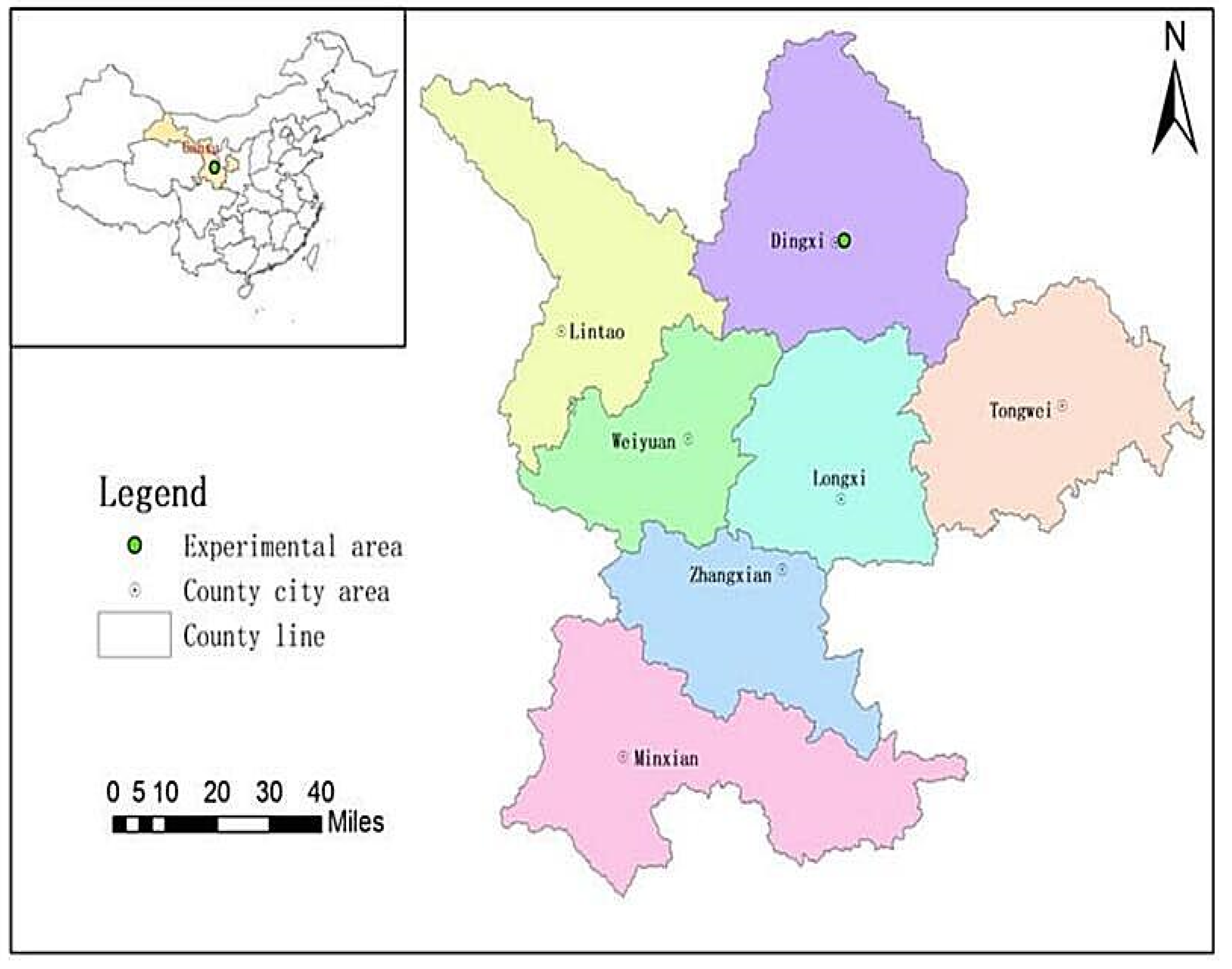
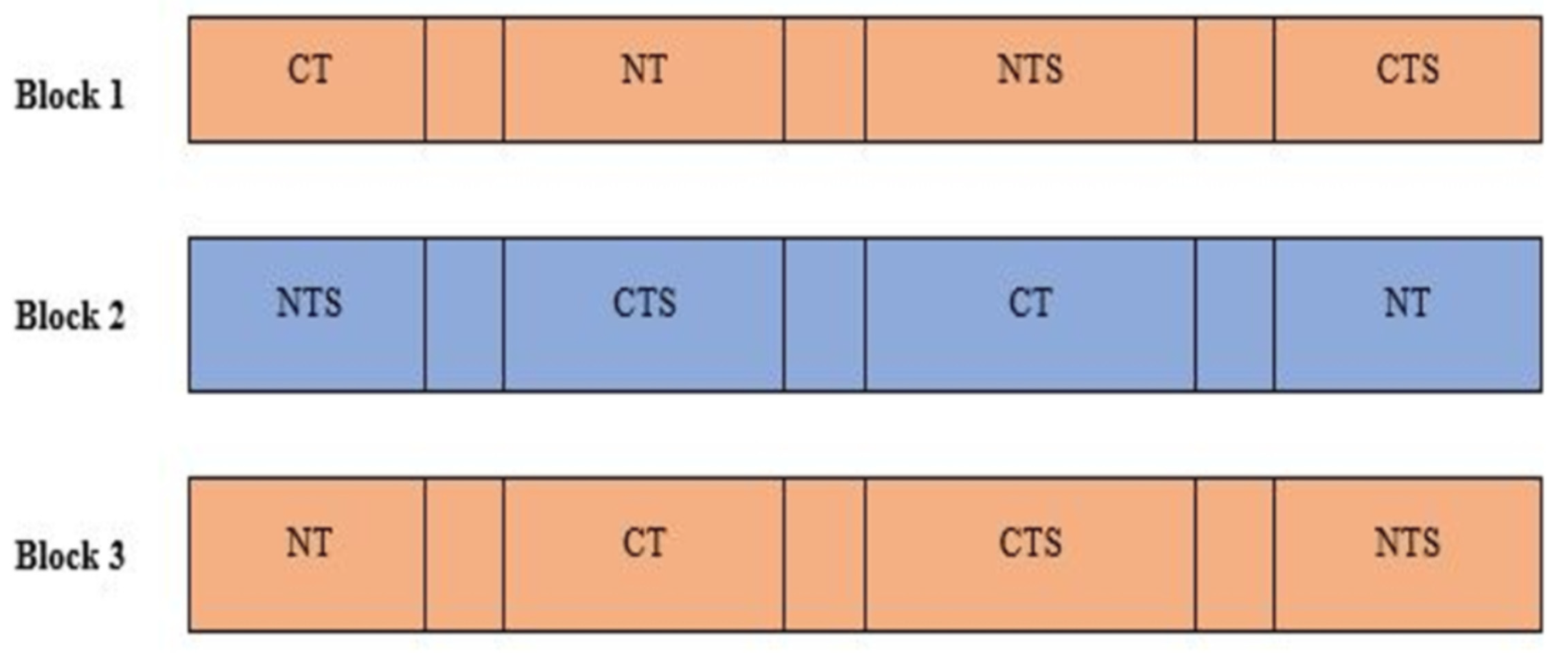
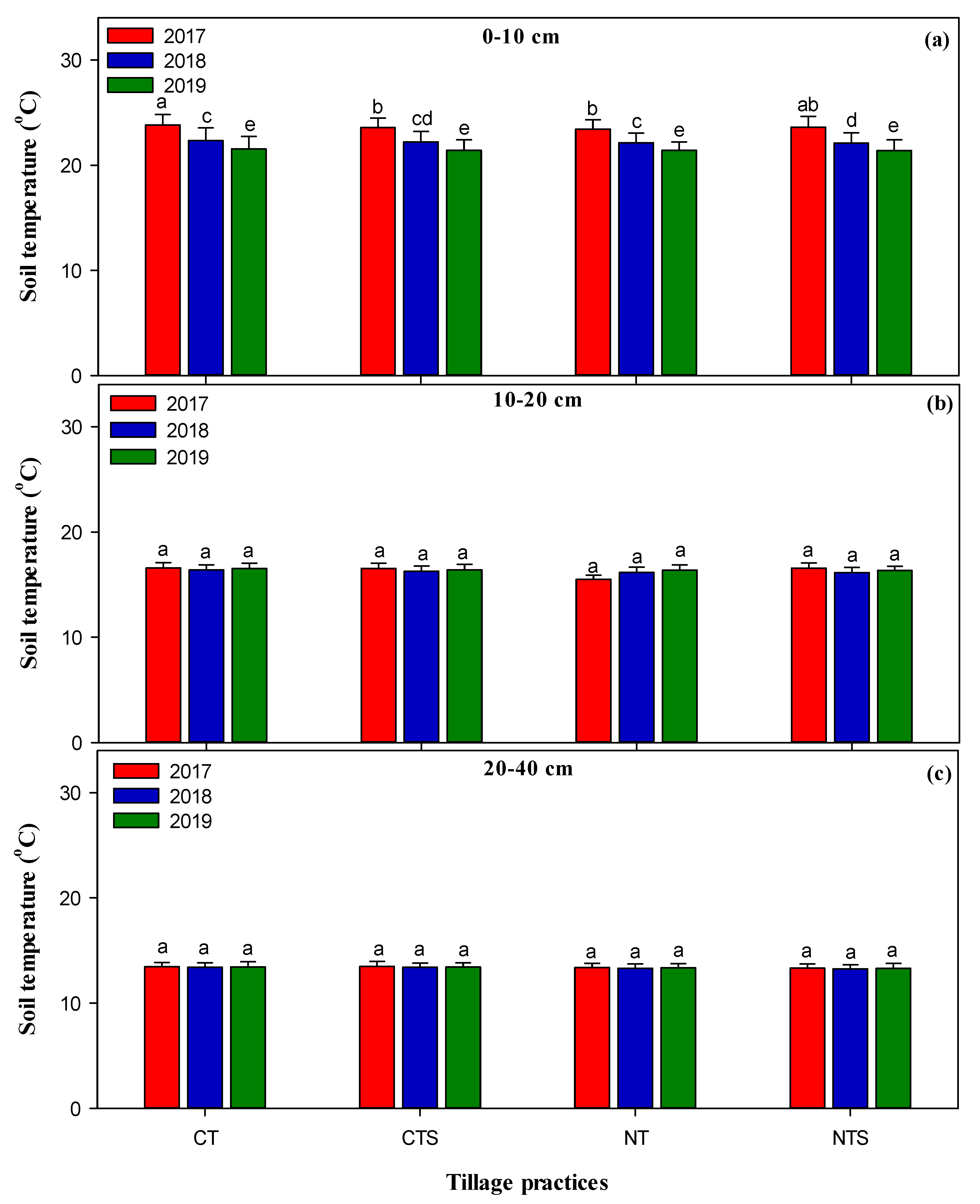
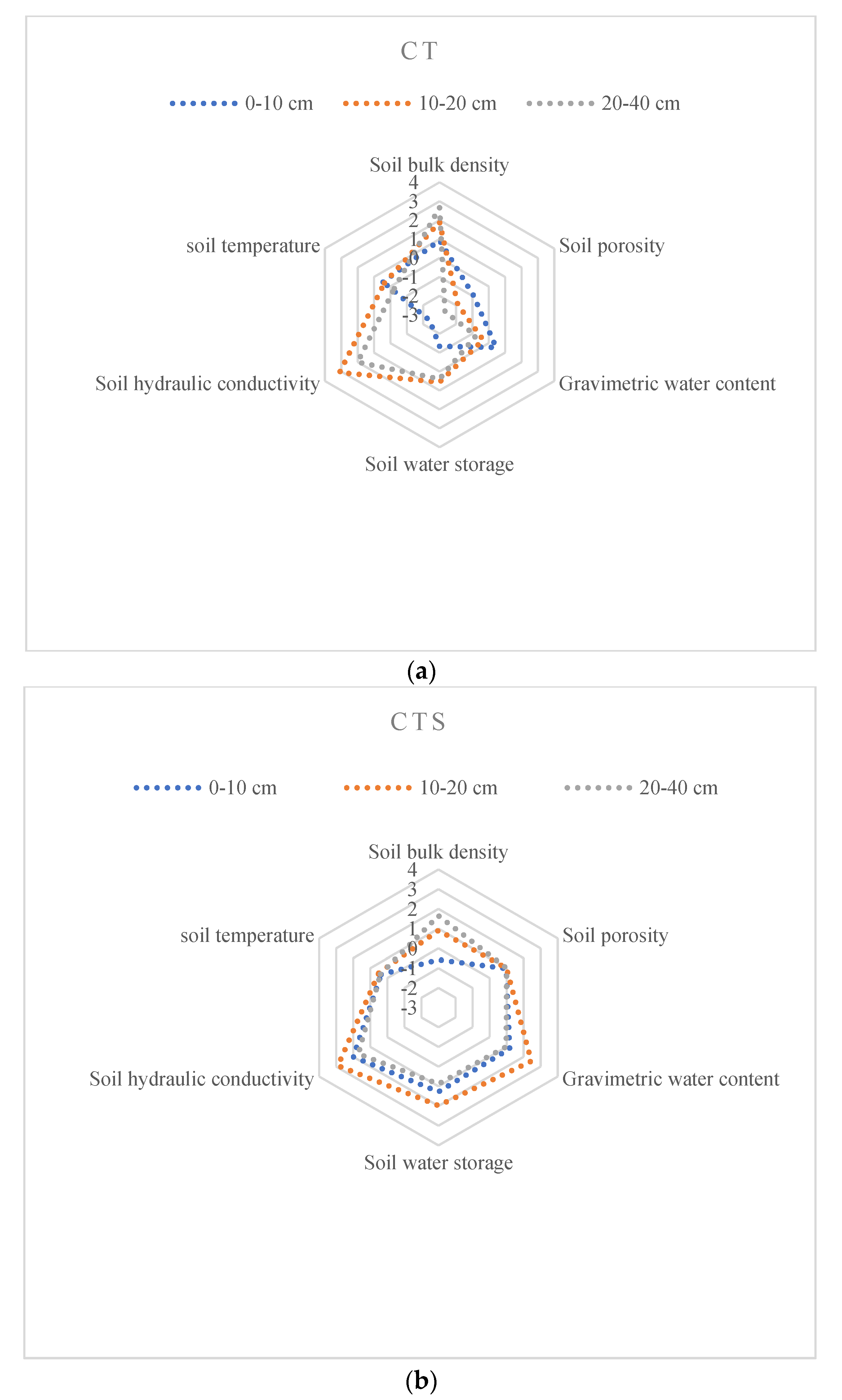
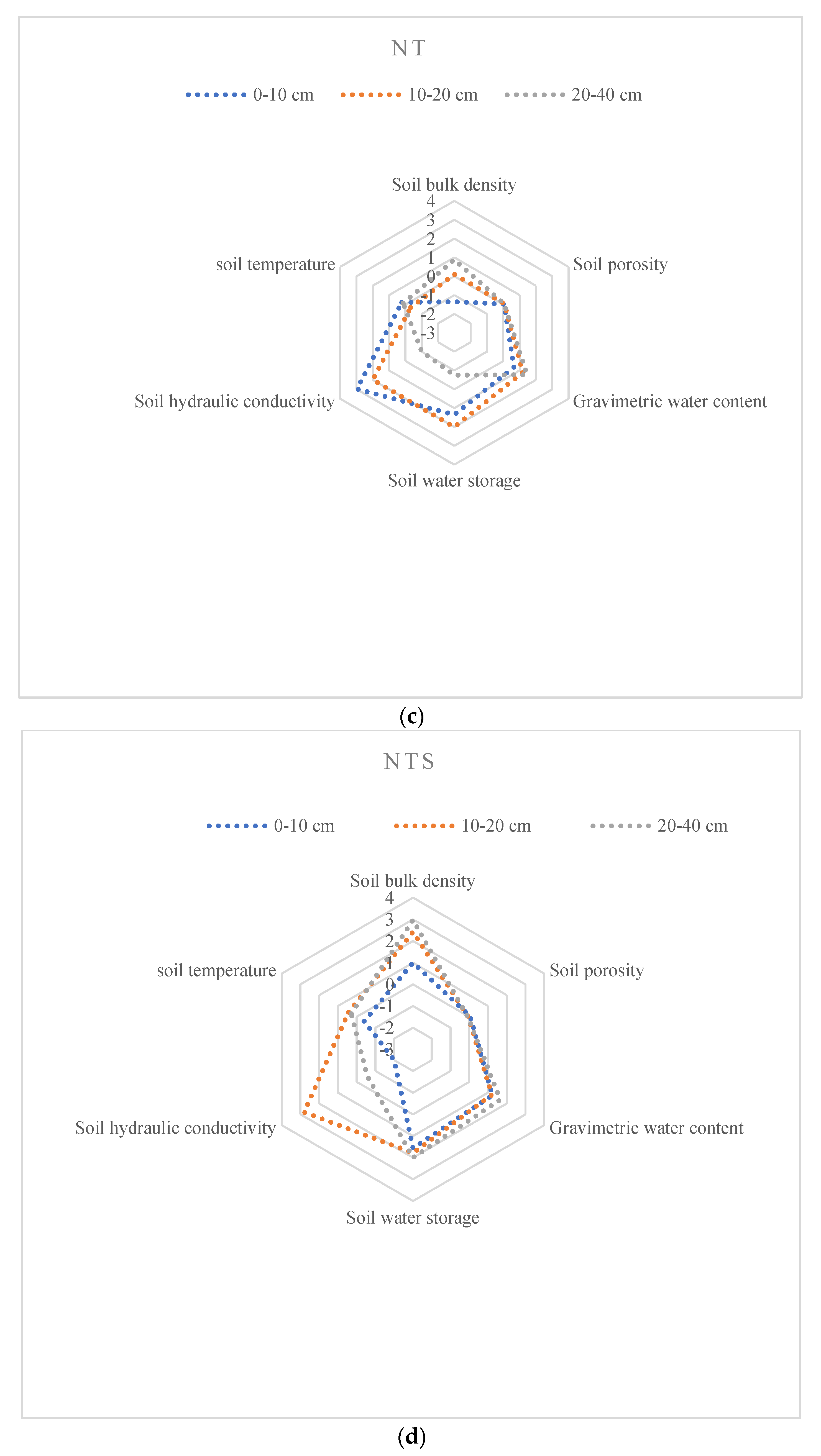
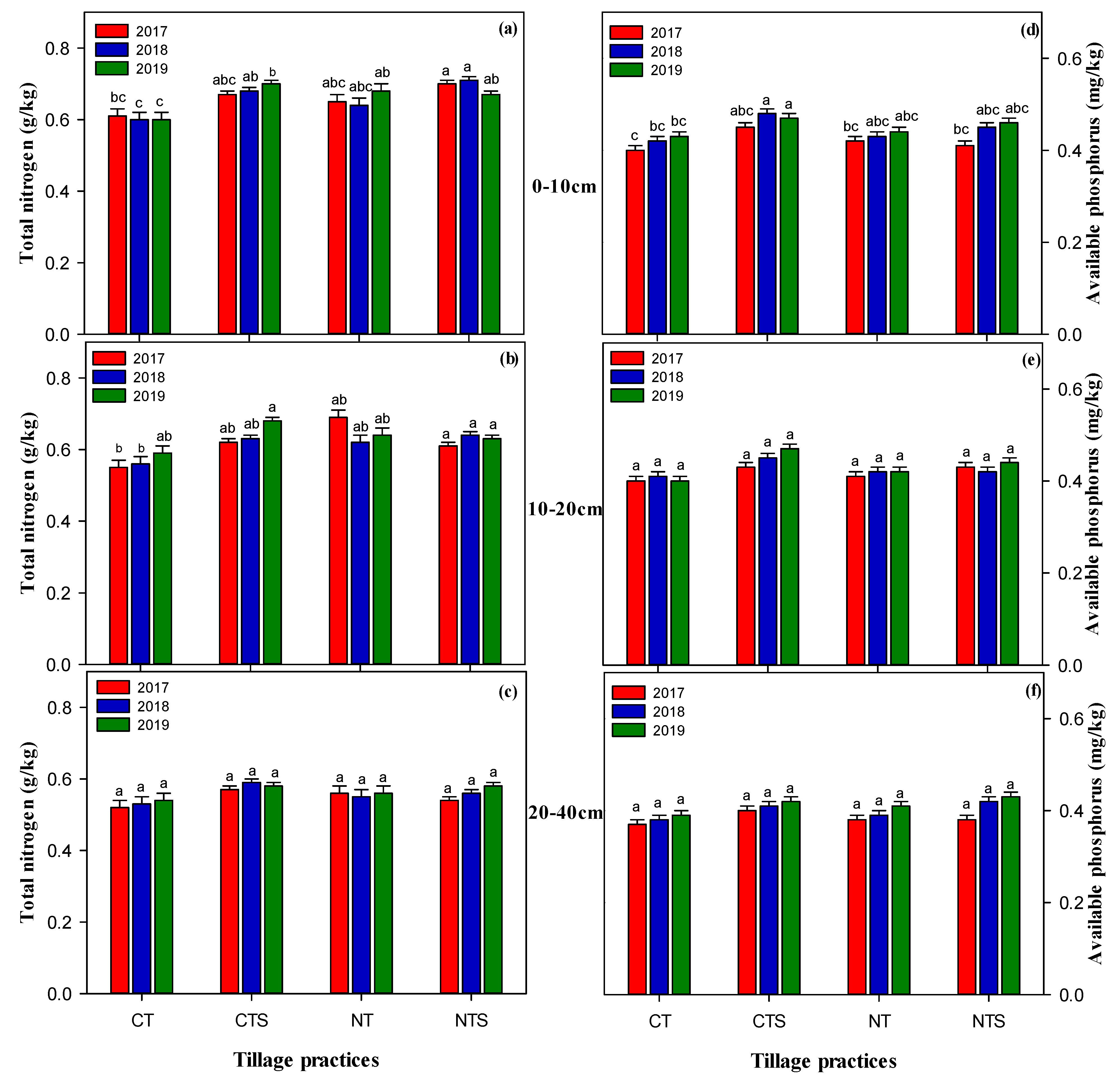
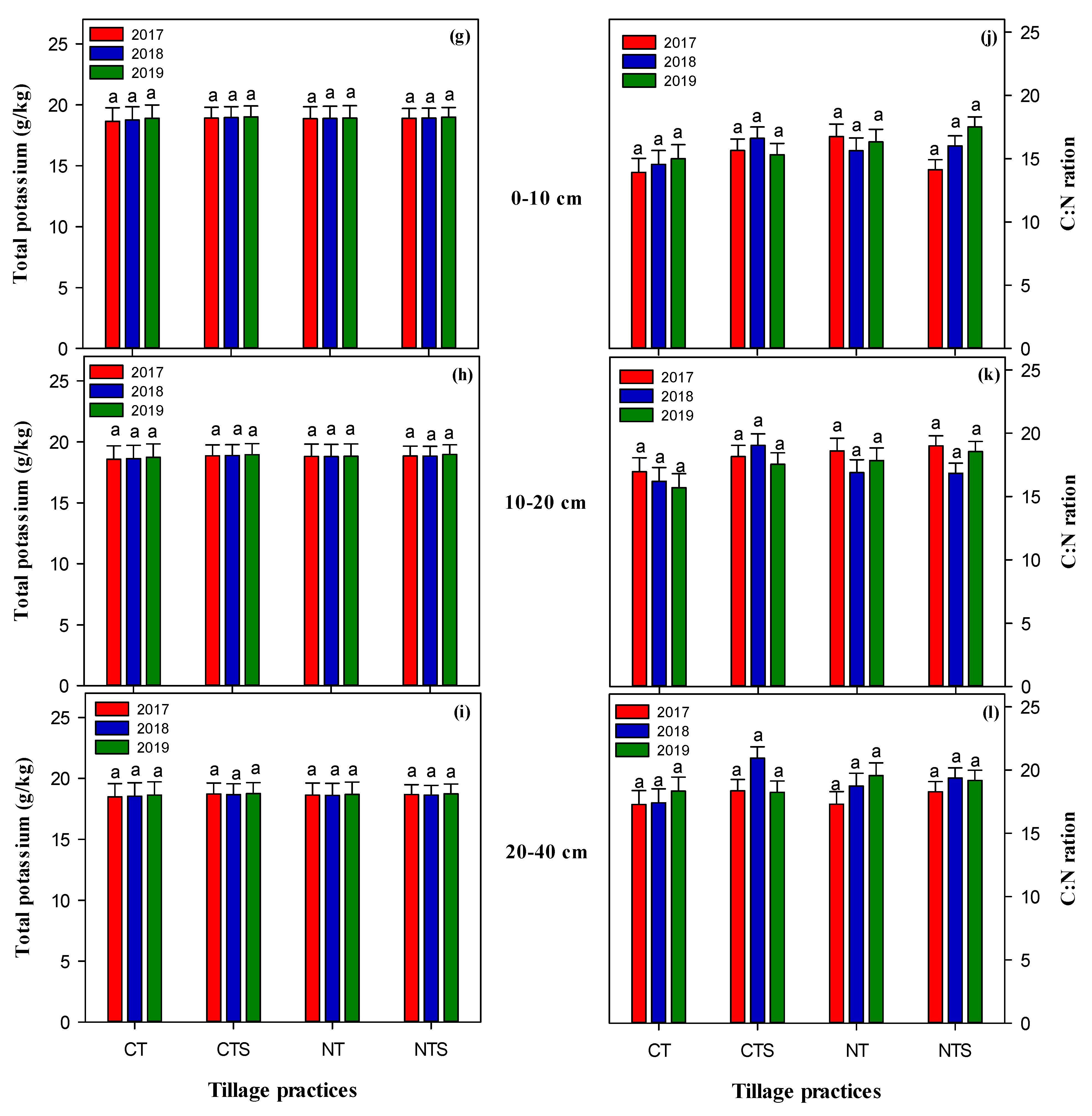
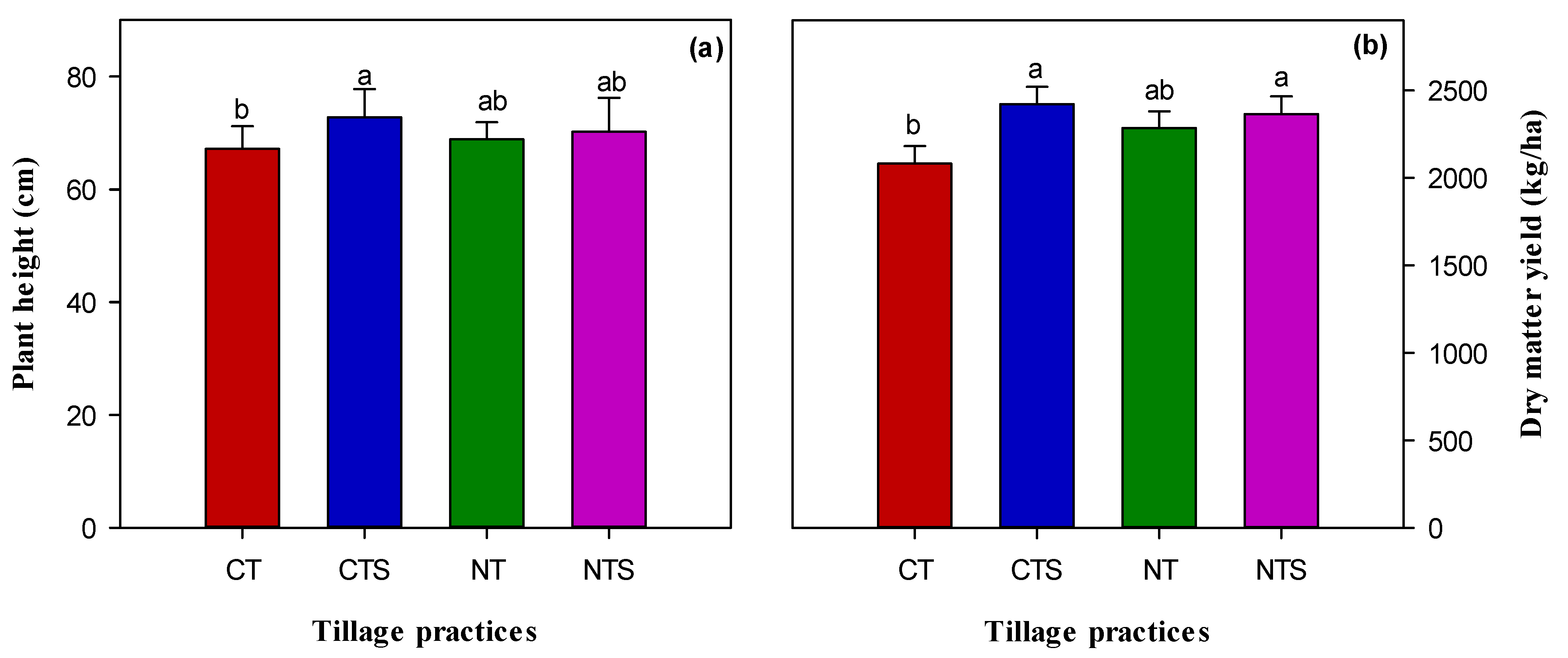
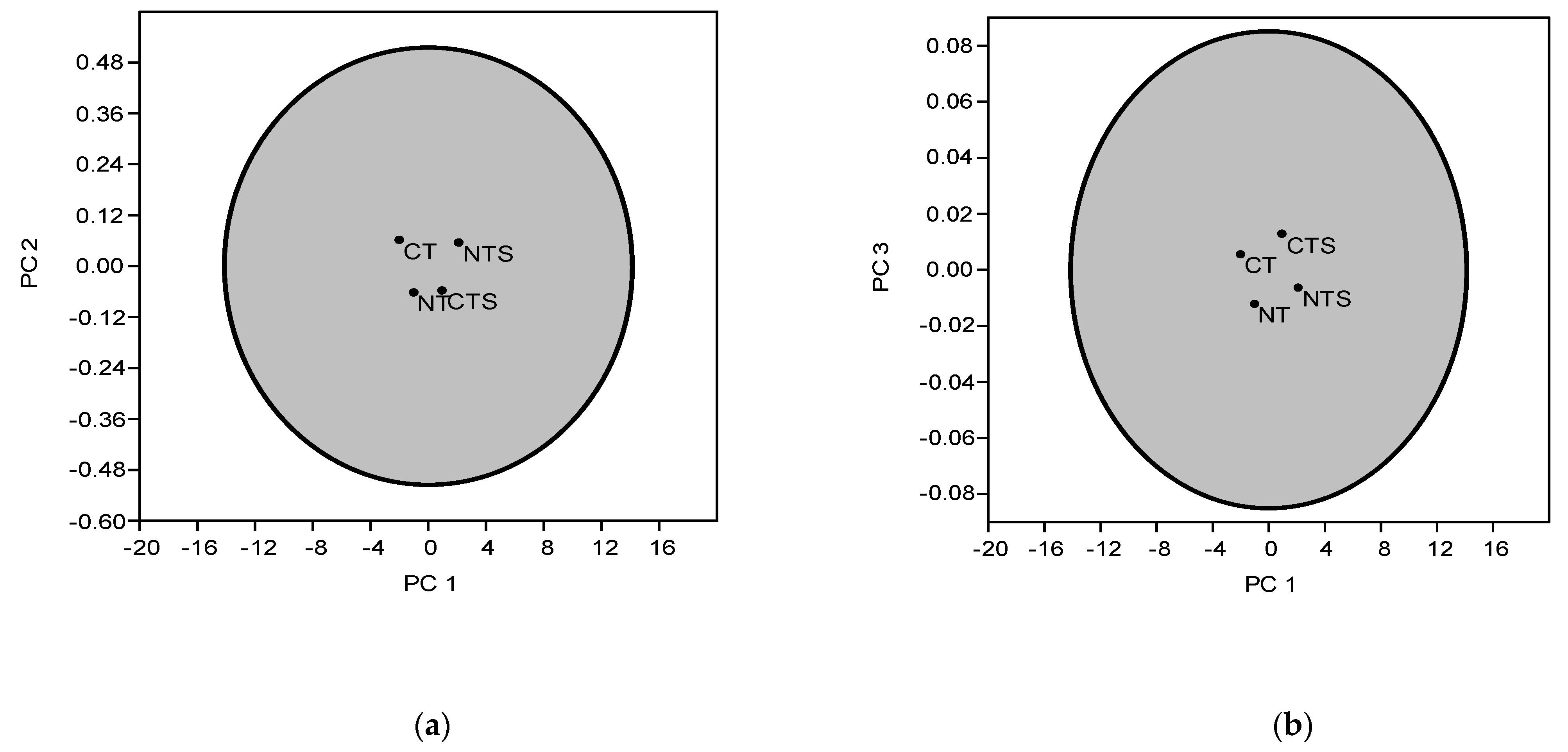
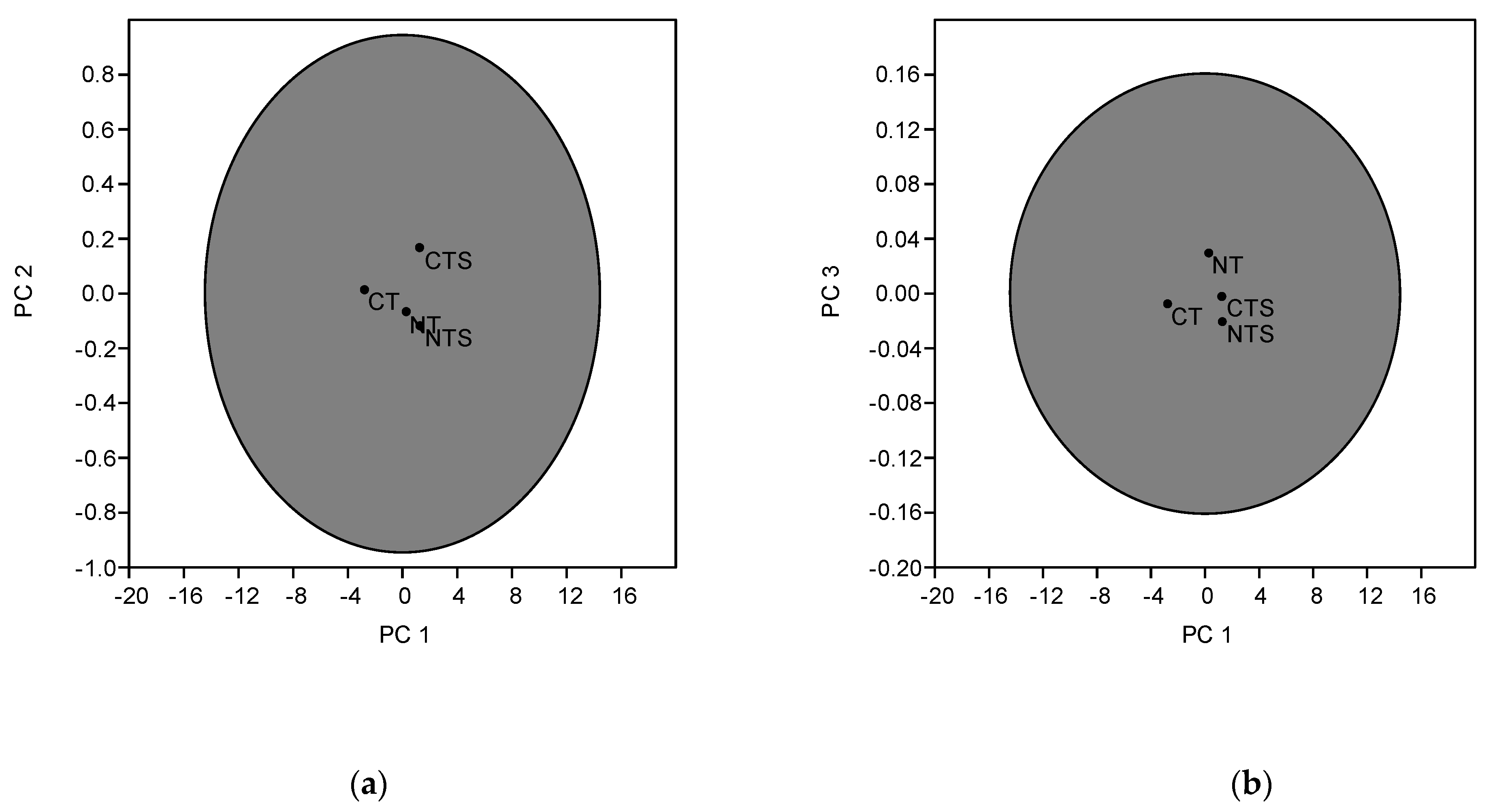
| Province | Station | Year | Plot Size | Crop | Crop Variety | Planting Date | Harvesting Date | Seed Rate (kg ha−1) | Plant Density (Plant m−2) | Fertilizer (g m−2) | Weed Control (L ha−1) |
|---|---|---|---|---|---|---|---|---|---|---|---|
| Gansu | Dingxi | 2017 | 24 m2 | wheat | Dingxi 42 | 15 March | 20 July | 187.5 | 400 | 08 March diammonium phosphate (14.58 g/m2), urea (6.25 g/m2) | 10 March herbicide (Red sun) with 30% glyphosate |
| Gansu | Dingxi | 2018 | 24 m2 | wheat | Dingxi 42 | 15 March | 18 July | 187.5 | 400 | 10 March diammonium phosphate (14.58 g/m2), urea (6.25 g/m2) | 10 March herbicide (Red sun) with 30% glyphosate |
| Gansu | Dingxi | 2019 | 24 m2 | wheat | Dingxi 42 | 15 March | 15 July | 187.5 | 400 | 12 March diammonium phosphate (14.58 g/m2), urea (6.25 g/m2) | 10 March herbicide (Red sun) with 30% glyphosate |
| Treatment | Short forms | Description | |||||||||
| T1 = Conventional tillage | CT | Above-ground portions of the wheat straws were removed after the harvesting of the wheat crop. Mouldboard plough at 20 cm depth ploughing was used for cultivation of land followed by disc harrow and planting. | |||||||||
| T2 = Conventional tillage with crop straw | CTS | Wheat straw was homogeneously incorporated into the field after harvest of the wheat and land cultivation was performed by using mouldboard plough at 20 cm deep followed by disc harrow and planting. | |||||||||
| T3 = No-tillage | NT | After harvesting the wheat crop, the above-ground portions of wheat straws were removed. Wheat crop was planted in 20 cm depth by using no-tillage crop planter without using any tillage implement. | |||||||||
| T4 = No-tillage with crop straw | NTS | By using no-tillage crop planter in the absence of any prior tillage having wheat residue-return to the no tillage soil, wheat was sown in 20 cm deep under standing previous wheat crop stocks. | |||||||||
| Property | Soil Layer (cm) | Measurement Method | |||
|---|---|---|---|---|---|
| 0–10 | 10–20 | 20–40 | 40–60 | ||
| Soil BD (g cm−3) | 1.38 | 1.37 | 1.42 | 1.46 | By core sampler method |
| Soil porosity (%) | 47.92 | 48.30 | 46.41 | 44.90 | (1 − (BD/P)) × 100 equation |
| Gravimetric soil water content (%) | 14.96 | 13.64 | 12.68 | 14.79 | Oven dry method |
| Soil water storage (mm) | 20.22 | 37.94 | 66.46 | 130.17 | SWC × BD × d/ρw |
| Soil TN (g kg−1) | 0.59 | 0.55 | 0.54 | 0.49 | Semimicro-Kjeldahl method |
| SOC (g kg−1) | 5.88 | 5.92 | 5.57 | 5.68 | Walkley-Black dichromate oxidation |
| C:N ratio | 9.96 | 10.76 | 10.31 | 11.59 | SOC/TN formula |
| AP (mg kg1) | 0.39 | 0.37 | 0.34 | 0.35 | Colorimetric method |
| TK (g kg−1) | 18.41 | 18.48 | 18.34 | 18.25 | Colorimetric method |
| Soil nitrate nitrogen (g kg−1) | 25.64 | 25.79 | 25.94 | 25.85 | 2 mol L−1 KCI extraction |
| Soil temperature (°C) | 6.83 | 6.14 | 5.46 | 5.78 | By digital soil thermometer |
| pH | 8.40 | 8.39 | 8.41 | 8.42 | By pH meter |
| ECe (dSm−1) | 0.33 | 0.33 | 0.36 | 0.34 | By EC meter |
| Soil Bulk Density (g cm−3) | |||
|---|---|---|---|
| Soil Layer Treatment | 0–10 cm | 10–20 cm | 20–40 cm |
| Tillage | |||
| CT | 1.43 ± 0.03 a | 1.47 ± 0.02 ab | 1.50 ± 0.02 ab |
| CTS | 1.37 ± 0.05 b | 1.43 ± 0.04 bc | 1.46 ± 0.03 bc |
| NT | 1.33 ± 0.03 b | 1.39 ± 0.04 c | 1.42 ± 0.03 c |
| NTS | 1.42 ± 0.03 a | 1.49 ± 0.03 a | 1.52 ± 0.02 a |
| Year | |||
| 2017 | 1.40 ± 0.05 a | 1.45 ± 0.05 a | 1.47 ± 0.05 a |
| 2018 | 1.37 ± 0.05 a | 1.42 ± 0.05 a | 1.46 ± 0.05 a |
| 2019 | 1.38 ± 0.06 a | 1.46 ± 0.04 a | 1.48 ± 0.03 a |
| Soil Porosity (%) | |||
| Treatment | 0–10 cm | 10–20 cm | 20–40 cm |
| Tillage | |||
| CT | 46.00 ± 1.31 b | 44.53 ± 1.03 bc | 43.36 ± 0.95 bc |
| CTS | 48.30 ± 1.91 a | 46.04 ± 1.58 ab | 44.91 ± 1.46 ab |
| NT | 49.48 ± 1.45 a | 47.25 ± 1.54 a | 46.08 ± 1.22 a |
| NTS | 45.91 ± 1.33 b | 43.73 ± 1.22 c | 42.31 ± 0.79 c |
| Year | |||
| 2017 | 46.95 ± 2.02 a | 45.19 ± 2.01 a | 44.18 ± 1.94 a |
| 2018 | 47.77 ± 2.07 a | 46.13 ± 1.96 a | 44.47 ± 2.10 a |
| 2019 | 47.55 ± 2.35 a | 44.84 ± 1.60 a | 43.84 ± 1.47 a |
| Increase or Decrease of Bulk Density (in Percentage) Compared with 2017 | ||||||||
| 2018 | 2019 | |||||||
| CT | CTS | NT | NTS | CT | CTS | NT | NTS | |
| 0–10 | −1.41 | −2.96 | −2.25 | −1.40 | 0.69 | −2.20 | −3.81 | −2.12 |
| 10–20 | −2.06 | −1.43 | −1.45 | −1.36 | −0.67 | 1.39 | 2.15 | 0.67 |
| 20–40 | −0.66 | −1.38 | 0.70 | −0.66 | −1.34 | 0.68 | 2.83 | 0.65 |
| Increase or decrease of soil porosity (in percentage) compared with 2017 | ||||||||
| 2018 | 2019 | |||||||
| CT | CTS | NT | NTS | CT | CTS | NT | NTS | |
| 0–10 | 1.92 | 1.04 | 2.85 | 1.09 | −0.55 | 1.31 | 2.86 | 1.38 |
| 10–20 | 2.79 | 1.63 | 1.67 | 2.32 | 1.43 | −1.67 | −1.91 | −0.85 |
| 20–40 | 0.88 | 1.69 | −0.25 | 0.3 | 1.46 | 0.83 | −2.78 | 0.90 |
| Soil Layer | Soil Hydraulic Conductivity (mm h−1) | ||||||||
| 0–10 cm | 10–20 cm | 20–40 cm | |||||||
| Year | |||||||||
| Treatment | 2017 | 2018 | 2019 | 2017 | 2018 | 2019 | 2017 | 2018 | 2019 |
| CT | 0.35 a | 0.38c | 0.32 a | 0.41 a | 0.42 b | 0.44 a | 0.36 a | 0.37 a | 0.41 a |
| CTS | 0.39 a | 0.51 a | 0.34 a | 0.48 a | 0.50 ab | 0.47 a | 0.41 a | 0.40 a | 0.38 a |
| NT | 0.36 a | 0.49 ab | 0.35 a | 0.42 a | 0.44b | 0.43 a | 0.39 a | 0.41 a | 0.36 a |
| NTS | 0.38 a | 0.41 bc | 0.31 a | 0.45 a | 0.55 a | 0.46 a | 0.37 a | 0.38 a | 0.42 a |
| p-value | 0.08 | 0.004 | 0.65 | 0.35 | 0.008 | 0.14 | 0.57 | 0.09 | 0.66 |
| Mean | 0.37 B | 0.45 A | 0.33 C | 0.44 B | 0.48 A | 0.45 AB | 0.38 A | 0.39 A | 0.39 A |
| Soil Layer | Changes of soil Ks (in percentage) in 2018 and 2019 compared with 2017 | ||||||||
| 0–10 cm | 10–20 cm | 20–40 cm | |||||||
| Year | |||||||||
| Treatment | 2018 | 2019 | 2018 | 2019 | 2018 | 2019 | |||
| CT | 8.57 | −9.37 | 2.43 | 7.31 | 2.77 | 13.88 | |||
| CTS | 30.7 | −14.7 | 4.16 | −2.12 | −2.50 | −7.89 | |||
| NT | 36.1 | −2.85 | 4.76 | 2.38 | 5.12 | −8.33 | |||
| NTS | 7.89 | −22.5 | 22.2 | 2.22 | 2.70 | 13.51 | |||
| Soil Water Content (%) | ||||||
| Early Crop Growth Stages | Late Crop Growth Stages | |||||
| Soil Layer (cm) | 0–10 cm | 10–20 cm | 20–40 cm | 0–10 cm | 10–20 cm | 20–40 cm |
| Treatments (T) | ||||||
| CT | 9.58 ± 1.09 a | 9.39 ± 1.32 ab | 9.43 ± 1.03 a | 5.43 ± 0.27 a | 4.41 ± 0.38 b | 4.21 ± 0.30 b |
| CTS | 10.12 ± 1.20 a | 10.33 ± 1.17 a | 9.21 ± 1.00 a | 6.25 ± 0.41 a | 5.34 ± 0.41 a | 4.51 ± 0.29 ab |
| NT | 9.70 ± 1.86 a | 8.35 ± 1.40 b | 8.47 ± 0.90 a | 5.87 ± 1.18 a | 4.91 ± 0.85 ab | 4.72 ± 0.62 a |
| NTS | 11.21 ± 1.00 a | 9.89 ± 1.20 a | 9.82 ± 1.35 a | 6.26 ± 1.09 a | 5.11 ± 0.74 ab | 4.75 ± 0.37 a |
| Years (Y) | ||||||
| 2017 | 9.79 ± 1.17 a | 8.89 ± 1.53 a | 8.85 ± 1.24 a | 5.75 ± 0.93 a | 4.86 ± 0.74 a | 4.56 ± 0.35 a |
| 2018 | 10.18 ± 1.64 a | 9.93 ± 1.19 a | 9.50 ± 0.98 a | 6.03 ± 0.85 a | 4.92 ± 0.66 a | 4.61 ± 0.58 a |
| 2019 | 10.48 ± 1.45 a | 9.65 ± 1.43 a | 9.30 ± 1.03 a | 6.08 ± 0.89 a | 5.05 ± 0.73 a | 4.48 ± 0.44 a |
| Soil water storage (mm) | ||||||
| Early crop growth stages | Late crop growth stages | |||||
| 0–10 cm | 10–20 cm | 20–40 cm | 0–10 cm | 10–20 cm | 20–40 cm | |
| Treatments (T) | ||||||
| CT | 13.79 ± 1.51 a | 27.60 ± 1.64 ab | 56.20 ± 2.78 a | 7.76 ± 0.35 a | 12.96 ± 1.16 b | 25.26 ± 2.13 b |
| CTS | 13.76 ± 2.45 a | 29.95 ± 1.15 a | 54.15 ± 2.46 a | 8.56 ± 1.23 a | 15.27 ± 2.02 a | 26.33 ± 1.65 ab |
| NT | 12.70 ± 1.22 a | 23.71 ± 2.89 b | 55.12 ± 1.23 a | 7.80 ± 0.52 a | 13.64 ± 1.25 ab | 26.80 ± 2.53 ab |
| NTS | 13.60 ± 1.19 a | 29.67 ± 2.32 a | 56.45 ± 2.34 a | 8.88 ± 1.43 a | 15.22 ± 1.54 a | 28.88 ± 1.92 a |
| Years (Y) | ||||||
| 2017 | 13.51 ± 2.12 a | 25.78 ± 1.20 a | 51.33 ± 0.46 a | 8.05 ± 0.71 a | 14.09 ± 0.65 a | 26.81 ± 1.33 a |
| 2018 | 14.86 ± 1.95 a | 27.40 ± 0.82 a | 55.10 ± 2.18 a | 8.26 ± 0.45 a | 13.97 ± 1.15 a | 26.92 ± 1.75 a |
| 2019 | 15.50 ± 1.58 a | 27.98 ± 1.72 a | 53.94 ± 1.91 a | 8.39 ± 1.12 a | 14.74 ± 1.77 a | 26.52 ± 0.86 a |
| Parameter | ||||||||||||||||||||||||
|---|---|---|---|---|---|---|---|---|---|---|---|---|---|---|---|---|---|---|---|---|---|---|---|---|
| Total Nitrogen (TN) | Available Phosphorous (AP) | Potassium (K) | C/N (Ratio) | |||||||||||||||||||||
| Soil Layer (cm) | ||||||||||||||||||||||||
| Source of variation | 0–10 | p-value | 10–20 | p-value | 20–30 | p-value | 0–10 | p-value | 10–20 | p-value | 20–30 | p-value | 0–10 | p-value | 10–20 | p-value | 20–30 | p-value | 0–10 | p-value | 10–20 | p-value | 20–30 | p-value |
| Treatment (T) | * | 0.00 | * | 0.00 | * | 0.00 | * | 0.00 | * | 0.01 | * | 0.01 | n.s. | 0.22 | n.s. | 0.35 | n.s. | 0.41 | n.s. | 0.19 | n.s. | 0.26 | n.s. | 0.67 |
| Year (Y) | n.s. | 0.91 | * | 0.01 | n.s. | 0.28 | * | 0.00 | n.s. | 0.47 | n.s. | 0.25 | n.s. | 0.38 | n.s. | 0.42 | n.s. | 0.56 | n.s. | 0.39 | n.s. | 0.49 | n.s. | 0.48 |
| (Y∗T) | n.s. | 0.16 | n.s. | 0.89 | n.s. | 0.91 | n.s. | 0.77 | n.s. | 0.86 | n.s. | 0.38 | n.s. | 0.87 | n.s. | 0.88 | n.s. | 0.96 | n.s. | 0.31 | n.s. | 0.87 | n.s. | 0.92 |
| Treatment | Soil pH | |||||||||||
|---|---|---|---|---|---|---|---|---|---|---|---|---|
| Soil Layer | ||||||||||||
| 0–10 cm | 10–20 cm | 20–40 cm | ||||||||||
| Year | ||||||||||||
| 2017 | 2018 | 2019 | 2017–2019 | 2017 | 2018 | 2019 | 2017–2019 | 2017 | 2018 | 2019 | 2017–2019 | |
| CT | 8.40 ± 0.02 a | 8.41 ± 0.01 a | 8.40 ± 0.01 a | 8.40 ± 0.01 A | 8.41 ± 0.02 a | 8.41 ± 0.01 a | 8.40 ± 0.01 a | 8.41 ± 0.01 A | 8.42 ± 0.02 a | 8.43 ± 0.01 a | 8.43 ± 0.01 a | 8.42 ± 0.01 A |
| CTS | 8.39 ± 0.05 a | 8.39 ± 0.04 a | 8.37 ± 0.02 a | 8.38 ± 0.03 A | 8.40 ± 0.03 a | 8.40 ± 0.02 a | 8.39 ± 0.03 a | 8.39 ± 0.02 A | 8.39 ± 0.04 a | 8.40 ± 0.03 a | 8.39 ± 0.03 a | 8.39 ± 0.03 A |
| NT | 8.40 ± 0.02 a | 8.40 ± 0.02 a | 8.38 ± 0.02 a | 8.39 ± 0.02 A | 8.41 ± 0.05 a | 8.41 ± 0.02 a | 8.40 ± 0.02 a | 8.41 ± 0.01 A | 8.41 ± 0.01 a | 8.42 ± 0.03 a | 8.40 ± 0.02 a | 8.41 ± 0.02 A |
| NTS | 8.38 ± 0.03 a | 8.41 ± 0.02 a | 8.36 ± 0.02 a | 8.38 ± 0.03 A | 8.40 ± 0.02 a | 8.41 ± 0.01 a | 8.37 ± 0.01 a | 8.39 ± 0.02 A | 8.40 ± 0.01 a | 8.42 ± 0.03 a | 8.39 ± 0.01 a | 8.40 ± 0.02 A |
| Mean | 8.39 ± 0.03 A | 8.40 ± 0.02 A | 8.38 ± 0.02 A | 8.39 ± 0.02 | 8.40 ± 0.02 A | 8.41 ± 0.01 A | 8.39 ± 0.02 A | 8.40 ± 0.02 | 8.40 ± 0.02 A | 8.42 ± 0.02 A | 8.40 ± 0.02 A | 8.41 ± 0.02 |
| Soil Depths (cm) | Soil Layers (cm) | |||||||||||||||
|---|---|---|---|---|---|---|---|---|---|---|---|---|---|---|---|---|
| Parameters | 0–10 | 10–20 | 20–40 | |||||||||||||
| BD | P | SWC | SWS | Ks | BD | P | SWC | SWS | Ks | BD | P | SWC | SWS | Ks | ||
| BD | −1 ** | −0.02 | −0.04 | −0.135 | 0.833 ** | −.833 ** | −0.002 | −0.04 | −0.201 | 0.755 ** | −.758 ** | −0.129 | −0.62 | −0.262 | ||
| 0–10 | P | 0.22 | 0.05 | −0.152 | −0.833 ** | 0.833 ** | 0.002 | 0.04 | 0.201 | −0.755 ** | 0.758 ** | 0.129 | 0.62 | 0.262 | ||
| SWC | 0.526 ** | 0.355 * | 0.09 | −0.09 | 0.611 ** | −0.855 ** | 0.081 | 0.207 | −0.207 | 0.537 ** | −0.254 | −0.222 | ||||
| SWS | 0.02 | −0.04 | 0.01 | 0.655 ** | 0.855 * | −0.02 | −0.64 | 0.086 | −0.66 | 0.254 | 0.248 | |||||
| Ks | 0.055 | −0.055 | −0.021 | 0.204 | 0.206 | 0.146 | −0.146 | 0.032 | 0.206 | 0.212 | ||||||
| BD | −1 ** | −0.049 | 0.205 | −0.224 | 0.933 ** | 0.934 ** | −0.107 | −0.278 | −0.083 | |||||||
| P | 0.049 | −0.205 | 0.224 | −0.933 ** | 0.934 ** | 0.107 | 0.278 | 0.083 | ||||||||
| 10–20 | SWC | 0.526 | −0.012 | 0.009 | −0.009 | 0.338 * | −0.78 | 0.048 | ||||||||
| SWS | 0.02 | −0.57 | −0.08 | −0.122 | 0.526 ** | −0.04 | ||||||||||
| Ks | −0.187 | 0.187 | 0.122 | 0.09 | −0.122 | |||||||||||
| BD | −1 ** | −0.065 | −0.04 | −0.104 | ||||||||||||
| P | 0.065 | 0.04 | −0.104 | |||||||||||||
| 20–40 | SWC | 0.526 ** | −0.313 | |||||||||||||
| SWS | −0.05 | |||||||||||||||
| Ks | ||||||||||||||||
| Treatment | Parameters | |||||||||||
|---|---|---|---|---|---|---|---|---|---|---|---|---|
| Soil Layer | ||||||||||||
| 0–10 cm | 10–20 cm | 20–40 cm | ||||||||||
| Year | ||||||||||||
| 2017 | 2018 | 2019 | Total Score | 2017 | 2018 | 2019 | Total Score | 2017 | 2018 | 2019 | Total Score | |
| Soil TN | ||||||||||||
| CT | −1.64 | −1.40 | −1.66 | −1.56 | −1.56 | −1.64 | −1.43 | −1.57 | −1.45 | −1.27 | −1.44 | −1.38 |
| CTS | 0.98 | 0.57 | 0.92 | 0.82 | 1.03 | 0.62 | 1.38 | 0.98 | 1.30 | 1.43 | 1.12 | 1.28 |
| NT | 0.10 | −0.41 | −0.58 | −0.29 | −0.14 | 0.08 | 0.17 | −0.11 | 0.38 | −0.47 | −0.37 | −0.15 |
| NTS | 0.54 | 1.23 | 0.15 | 0.64 | 0.67 | 0.94 | −0.12 | 0.41 | −0.22 | 0.31 | 0.69 | 0.26 |
| Soil AP | ||||||||||||
| CT | −1.29 | −0.88 | −1.40 | −1.19 | −1.36 | −0.89 | −1.27 | −1.23 | −0.88 | −0.85 | −1.28 | −1.00 |
| CTS | 1.49 | 1.63 | 1.29 | 1.47 | 1.21 | 1.66 | 1.40 | 1.39 | 1.68 | 0.22 | 0.33 | 0.74 |
| NT | 0.09 | −0.74 | −0.36 | −0.33 | −0.50 | −0.64 | −0.51 | −0.50 | −0.24 | −0.87 | −0.47 | −0.52 |
| NTS | −0.29 | −0.25 | 0.46 | −0.026 | 0.64 | −0.12 | 0.38 | 0.34 | −0.56 | 1.54 | 1.41 | 0.79 |
| Soil TK | ||||||||||||
| CT | −0.18 | −0.42 | 0.06 | −0.18 | −0.22 | −0.15 | −0.27 | −0.14 | −0.05 | −0.13 | 0.08 | −0.03 |
| CTS | 0.48 | 0.65 | 0.29 | 0.47 | 0.58 | 0.72 | 0.69 | 0.57 | 0.82 | 0.50 | 0.49 | 0.60 |
| NT | −0.22 | −0.35 | −0.17 | −0.24 | 0.11 | 0.32 | −0.35 | −0.02 | 0.34 | −0.25 | −0.28 | −0.06 |
| NTS | 0.32 | −0.14 | 0.51 | 0.23 | 0.45 | 0.55 | 0.57 | 0.52 | 0.20 | −0.18 | 0.19 | 0.07 |
| C/N ratio | ||||||||||||
| CT | −1.52 | −1.25 | −1.05 | −1.27 | −0.29 | −1.45 | −1.36 | −1.03 | −1.21 | −1.75 | −1.02 | −1.32 |
| CTS | 1.22 | 1.07 | 0.97 | 1.08 | 0.58 | 1.25 | 1.89 | 1.17 | 1.05 | 1.31 | 1.20 | 1.18 |
| NT | 1.41 | 1.13 | 0.88 | 1.14 | 1.50 | 0.87 | 0.27 | 0.88 | 1.85 | 0.76 | 1.74 | 1.45 |
| NTS | 1.24 | 1.40 | 1.02 | 1.22 | 1.70 | 1.43 | 0.82 | 1.24 | 1.42 | 0.17 | 0.98 | 0.85 |
| pH | ||||||||||||
| CT | −0.57 | 0.10 | 0.01 | −0.15 | −0.70 | 0.20 | 0.13 | −0.09 | −0.18 | −0.20 | 0.08 | −0.10 |
| CTS | 0.93 | 1.89 | 0.09 | 0.97 | 0.37 | 0.96 | 1.39 | 0.70 | 0.71 | 0.92 | 0.65 | 0.76 |
| NT | −0.34 | 0.90 | 0.20 | 0.25 | −0.45 | 0.08 | 0.60 | 0.10 | −0.40 | 0.03 | 0.67 | 0.1 |
| NTS | 0.98 | 1.52 | 0.50 | 1.00 | 0.87 | 1.22 | 1.04 | 0.90 | 0.80 | 1.03 | 0.94 | 0.92 |
Publisher’s Note: MDPI stays neutral with regard to jurisdictional claims in published maps and institutional affiliations. |
© 2021 by the authors. Licensee MDPI, Basel, Switzerland. This article is an open access article distributed under the terms and conditions of the Creative Commons Attribution (CC BY) license (https://creativecommons.org/licenses/by/4.0/).
Share and Cite
Sadiq, M.; Li, G.; Rahim, N.; Tahir, M.M. Sustainable Conservation Tillage Technique for Improving Soil Health by Enhancing Soil Physicochemical Quality Indicators under Wheat Mono-Cropping System Conditions. Sustainability 2021, 13, 8177. https://doi.org/10.3390/su13158177
Sadiq M, Li G, Rahim N, Tahir MM. Sustainable Conservation Tillage Technique for Improving Soil Health by Enhancing Soil Physicochemical Quality Indicators under Wheat Mono-Cropping System Conditions. Sustainability. 2021; 13(15):8177. https://doi.org/10.3390/su13158177
Chicago/Turabian StyleSadiq, Mahran, Guang Li, Nasir Rahim, and Majid Mahmood Tahir. 2021. "Sustainable Conservation Tillage Technique for Improving Soil Health by Enhancing Soil Physicochemical Quality Indicators under Wheat Mono-Cropping System Conditions" Sustainability 13, no. 15: 8177. https://doi.org/10.3390/su13158177
APA StyleSadiq, M., Li, G., Rahim, N., & Tahir, M. M. (2021). Sustainable Conservation Tillage Technique for Improving Soil Health by Enhancing Soil Physicochemical Quality Indicators under Wheat Mono-Cropping System Conditions. Sustainability, 13(15), 8177. https://doi.org/10.3390/su13158177






